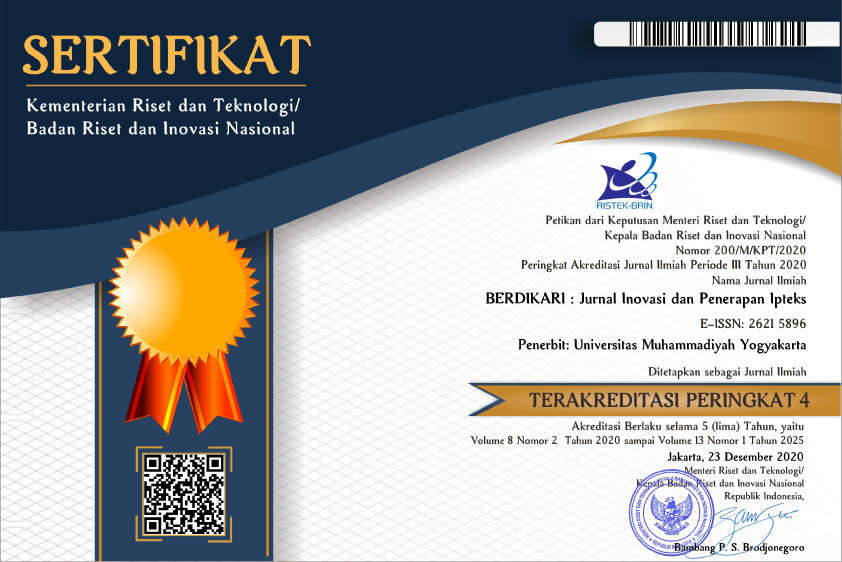Kemandirian Ekonomi Melalui Optimalisasi Peran Karang Taruna
DOI:
https://doi.org/10.18196/bdr.8283Keywords:
Digital marketing, Karang Taruna, economic independence, vegetables and fruitsAbstract
Karang Taruna (Youth Organization) becomes the hope for development resources in all aspects of the village. The village economic development needs to be directed towards the independence in order to be sustainable. Land resources that are productive but have not been utilized are potential to be the capital for the village economic independence development. The available land is used by Karang Taruna to be made as Vegetable and Fruit Gardens. The management of village’s Vegetable and Fruit Gardens has not been optimal yet. Thus, efforts in optimizing it need to be taken. The goal of community empowerment is to optimize the role of Karang Taruna of Keboan Anom Village and to develop the Vegetable and Fruit Gardens to achieve village economic independence. The community empowerment program is carried out in stages, namely socialization, training on processing food products, digital marketing workshops, and financial management. The results of community empowerment show that processed vegetables and fruit products having high economic value are produced as the source of income for Karang Taruna and as the additional income for Keboan Anom Village, the information technology-based marketing (digital marketing) models is well-understood, and the organizational financial management is good.
References
Giniuniene, J. & Jurksiene, L. (2015). DynamicCapabilities, Innovation and Organizational Learning: Interrelations and Impact on Firm Performance. Procedia-Social and Behavioral Science, 213 (1), 985-991.
Jong, J. & Vermeulen, P. (2006). Innovation in SMEs: An Empirical Investigation of the Input-Throughput-Output-Performance Model.
Melville, Nigel. (2010). “Information Systems Innovation for Environmental Sustainability,” MIS Quarterly, (34: 1) pp.1-21.
Mokodongan, Budi Kurniawan, Rieneke L. E. Sela, dan Hendriek H. Karongkong. (2014). Identifikasi Pemanfaatan Kawasan Bantaran Sungai Dayanan di Kota Mobagu. Sabua. Vol. 6, No. 3: 273-281.
Shofa, Abd Muid Aris. (2016). “Peran Pemuda dalam Pendampingan Mahasiswa Difabel dan Implikasinya terhadap Ketahanan Pribadi Pemuda (Studi di Pusat Layanan Difabel (PLD) UIN Sunan Kalijaga Yogyakarta)”, Jurnal Ketahanan Nasional, Vol. 22, No. 2: 199-216.
Supriyanto, Agus. (2015). Profil Desa Keboan Anom Gedangan Sidoarjo. http://kkndesakeboananom.blogspot.com/2015/08/posbindu.html diakses 25 Desember 2019.
Terziovski, M. (2010). Innovation Practice and its Performance Implications in Small and Medýum Enterprises (SMEs) in The Manufacturing Sector: A Resource- based View. Strategic Management Journal, 31: 892-902.
UMSIDA, L. (2016). Rencana Strategis Pengabdian kepada Masyarakat Universitas Muhammadiyah Sidoarjo 2016-2020. Sidoarjo: LPPM Universitas Muhammadiyah Sidoarjo.
Downloads
Published
Issue
Section
License
Copyright
Authors retain copyright and grant BERDIKARI Jurnal Inovasi dan Penerapan IPTEK the right of first publication with the work simultaneously licensed under an Attribution 4.0 International (CC BY 4.0) that allows others to remix, adapt and build upon the work with an acknowledgment of the work's authorship and of the initial publication in BERDIKARI Jurnal Inovasi dan Penerapan IPTEK.
Authors are permitted to copy and redistribute the journal's published version of the work (e.g., post it to an institutional repository or publish it in a book), with an acknowledgment of its initial publication in BERDIKARI Jurnal Inovasi dan Penerapan IPTEK
License
Articles published in the BERDIKARI Jurnal Inovasi dan Penerapan IPTEK) are licensed under an Attribution 4.0 International (CC BY 4.0) license. You are free to:
- Share — copy and redistribute the material in any medium or format.
- Adapt — remix, transform, and build upon the material for any purpose, even commercially.
This license is acceptable for Free Cultural Works. The licensor cannot revoke these freedoms as long as you follow the license terms. Under the following terms:
- Attribution — You must give appropriate credit, provide a link to the license, and indicate if changes were made. You may do so in any reasonable manner, but not in any way that suggests the licensor endorses you or your use.
- No additional restrictions — You may not apply legal terms or technological measures that legally restrict others from doing anything the license permits.




